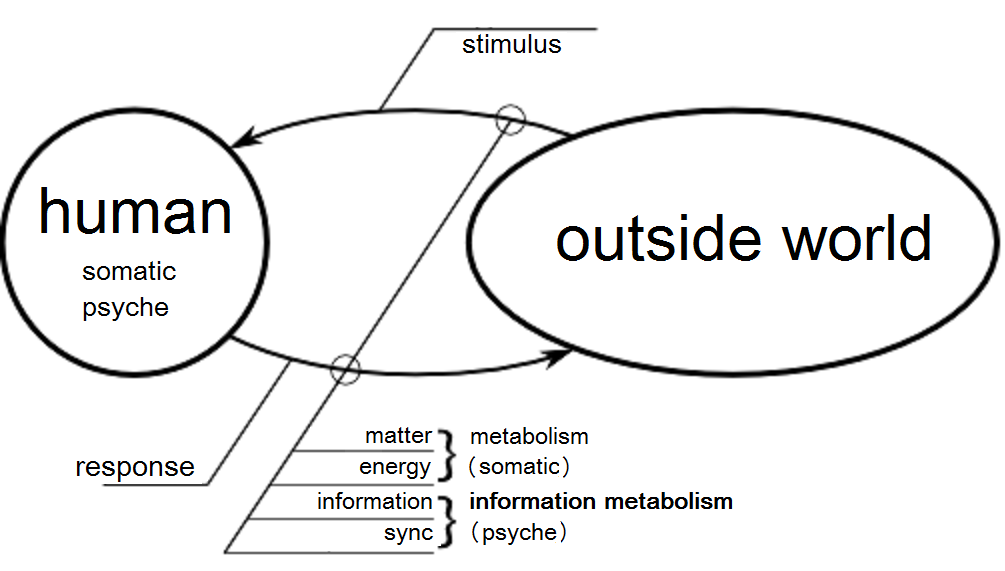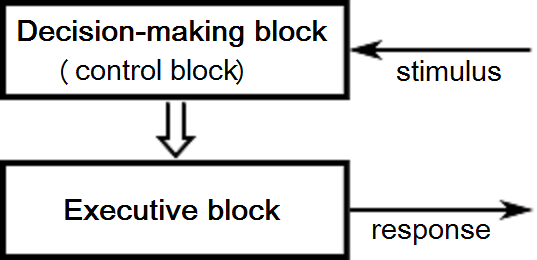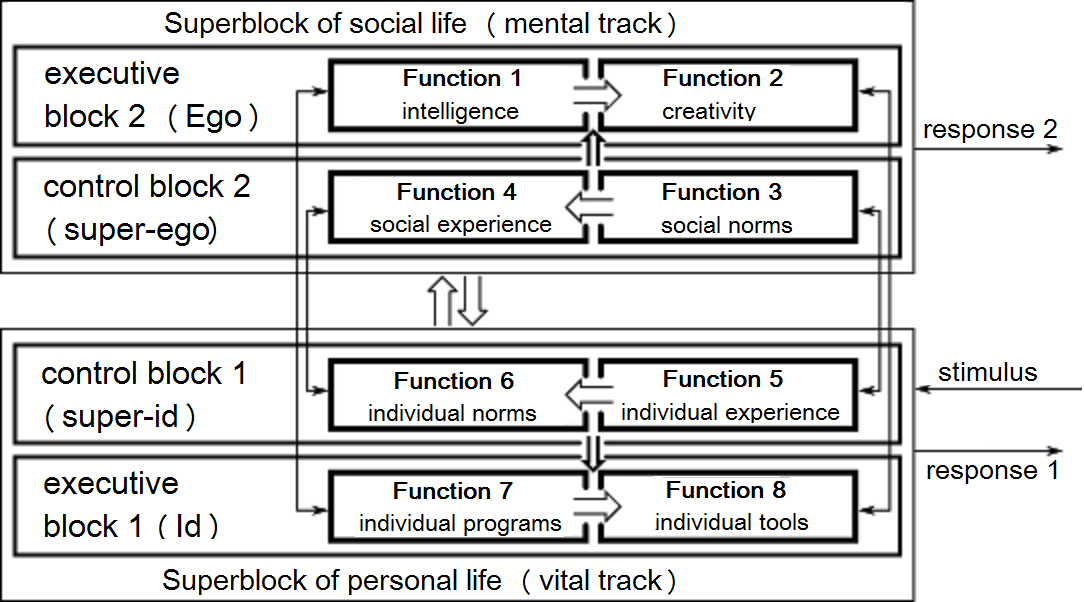System structure of the psyche
…Socionics is the science of the socion, the socionic nature of human and the socionic structure of society, different types of people's information metabolism and different forms of relationships between them, the structure and functioning of the model of information metabolism..
A.Augustinavichiute
Characteristics (properties and parameters) of an element are defined by the system in consequence and in accordance with the objectives which are to be achieved by the system (tasks, problems). Distinctive peculiarities, characteristics and parameters of a person are defined by society, which in turn performs a certain task, mission inside the macro system of "humanity". Analyzing the structure of relations (stimuli and responses) of the system, it is possible to estimate the structure and characteristics of the elements required for the functioning of the system and needed for achieving its goals [1], and making possible then to construct models of elements, by the way of determining their connections and researching the system functioning. Having analyzed the system "person - outside world" from a perspective of systemology (in particular, control theory), it is possible to identify the structure of the psyche. Further, the basic information of structure of the psyche is resented and the structure of the psyche model is shown.
The greater part or even all relations of the person with animate or inanimate objects are defined by the psyche structure of people...
A.Augustinavichiute
To reveal the structure of the psyche, we appeal to the idea of a person as an element of the system (Figure 1).

Figure 1. Interaction of person and outside world
We wonder - how must be organized a system element in order to perceive the control actions, and in accordance with the appropriate parameters (the characteristics of individuality and personality), to produce the executing reaction? What is the structure of the psyche, which provides an informational interaction of person and outside world?
Such universal structure is well known from the general theory of management (and just in common sense!):

Figure 2. Control and execution module
In control theory, such structures are usually named as the control and execution module. So, in general, the psyche of any "live" element of nature is arranged, and the control theory allows to prove the hereinafter contained. However, we will do reasonably - use the method of discourse (from the Greek Discourse - reasoning) - try to reason, resorting "to the existed concepts of methods in ordinary language, which are clear and accessible to everyone" (C. G. Jung [2])
- What is needed for taking the right decision?” Firstly to decide: whether the task is addressed to me. If "mine", in other words at address - have to perform and, therefore, engage in world activity. If "not mine" - you can try not to react. Secondly, if a job is "mine," estimate, "I can", I do what I have to do, or "cannot", and then you have to think of something. It is easy to see that these two procedures, decision-making processes, in general, are necessary and sufficient.
- What is needed for the execution of the decision (if the task "mine" and "I am able")? Firstly, presence of a set of rules (technologies, procedures) or a work "program" of the job, and second, - a work tool for the implementation of the result - it is necessary and sufficient for the execution.
If we imagine the structure element of the system (in this case, the mind), as is generally composed of blocks and sub-blocks, for the case of "usual" functioning (the usual conditions and problems, when "mine" and "I am able", a program and a tool), it might be represented as in Figure 3. So that the structure looked more terminologically correct, we add following comments. It is easy to prove, that in making the decision about the control stimulus, the answer to an important question for each person "mine - not mine", and therefore, the engagement[1] in world activity is based on a personal experience, and the answer to a referential question (assessment) "I can - I can't " actually indicates the presence or absence of individual experience and individual norms.

Figure 3. Structure of the «automatic» functioning of the psyche
When the assignment is "mine", I know how to do it, when there is a "program" and "tools" – all is usual and habitual ("Everyday"). It can have the function of a machine - "not thinking" - in nature everything is arranged so that there are vital important processes of the everyday functioning at the automatic level[2]. However, life adds us quite regularly new assignments, often "not mine", such that I "can not". In these cases, the "program" and "tools" are often absent. Nothing can be done - it is a tribute of evolution, development, and progress. What can we do in a real - changing, evolving life? We can certainly ignore these tasks (in which case no response). But such way is not always possible, as a rule, subject is exposed to "persistent management", and it is necessary to think, aware of the situation - "If not me, then who?" Simplifying (the control theory is justified strictly), and reducing the explanation, the process of solving new problems can be summarized as follows.
- If the task is not "mine", and forced me to decide I need to refer "to the public", for others (because someone decided something like that). In other words, I need to ask the social norms. If a new task I "can not" decide, I’ll have to "dig" in the experience of other solutions of new problems, that is, ask the social experience. Consequently, the structure of the element of the system (the psyche) should provide appropriate sub-blocks (functions), combined in an additional block of decision-making (control block 2 – Figure 4), which would help the basic block.
- If I don’t have a work program for the execution of a new job, I’ll have to thought up the program with using the "intelligence". If there is no suitable instrument, must be creative and create a new tool - "created" (hereinafter creativity is understood in a broad sense, as the creation of a new one). Therefore the structure must again include subunits combined in an additional block of execution (executive block 2 – Figure 4), which would help the basic block.
Some comments about the process of solving new problems:
In the modern researches of processes of the solution of tasks by humans and machines, the great importance attach to heuristics (the Oxford English Dictionary heuristics - to find the truth). The so-called basic learning heuristic of Minsky and Selfridge recommends: "In the new circumstances try to use techniques similar to those, that work best in situations similar to the known" [3].
The term "intelligence" isn’t well enough defined and unambiguous in literature. There are a number of fundamentally different interpretations of intelligence (J. Piaget, C. Spearman, L. Thurstone, H. Eysenck, C. Burt, D. Wechsler, F. Vernon). One of the electronic "multimedia encyclopedias of knowledge" contains such definition: "Intellect (from Lat. Intellect - understanding, knowledge) - an ability to implement a process of learning and a search for effective solutions to problems, particularly when learning new conditions of life problems." In the concept of modern socionics, we proposed to define intelligence as an ability to analyze new problems, to seek and develop solutions. There is also a humorous definition of intelligence: "Every intelligent person knows what intelligence is. This is what others have not!"
Thus, the information structure of the psyche as a system component, which is able to function in usual (everyday) conditions and to solve new problems, arising in the process of evolution of the system, might look like, as shown in Figure 4.
Here the single arrows (->) indicate communication between the functions and the outside world, and the double arrows (=>) indicate control transfer, i.e., the sequence of operation of the functions and blocks in the process of decision-making and execution (the latter process is sometimes incorrectly referred to as the transfer of information). Arguing about the person as an element of the system, we have identified the structure of the psyche. Let’s consider this structure. There are two conspicuous superblocks in the structure of the psyche. At first glance, these blocks are similar in composition and arranged like a "mirror" for each other. Numbering subunits (functions) in the structure is accepted such as it is shown in Figure 4.

Figure 4. Normalized structure of the psyche
Functions (role) of superblocks, in general, follow from those processes of information processing, which were discussed above. The "life activity", of course, means the psychic:
- Superblock of personal life (vital track) provides a functioning of the psyche in normal, usual conditions, at the solution of wonted tasks. Typically, these units operate automatically (in the nature and in the technical systems created by humans) - people unconsciously decide the individually necessary tasks, as they say, "without thinking". But, on second thought, can realize (like "hindsight", after it's done) their thoughts and actions - in other words, a person at first does usual actions, and then can realize what he did[3]. This level of the psyche functioning is called the level of individuality or level of vital activity. A. Augusta borrowed terms from psychoanalysis, the executive block1 called id, and for control block1 introduced Superid name.
- Superblock of social life (mental track) starts to work when at some point of decision-making or execution of the block of individual life, the new task, which was received from the supra system, can’t be solved by a habitual way. In this case, the respective sub-block (function) of the superblock of personal life "asks for help", ie, transfers the control to the related sub-block (function) of the superblock of social life (relationships are shown by arrows). This level of the psyche functioning is called the social level. A. Augustinavichiute borrowed terms from psychoanalysis, the executive block 2 called ego, and the control blok 2 - Superego.
Reasoning about the decision-making and execution, for simplicity, we assumed that the problem comes first to the decision-making block (control block 1), the sub-block of individual experience (function 5), and the response (outcome) issues from the executive block1 - if the problem is habitual (function 8) or from the executive block 2 - if the problem is new (function 2). In fact, the information flow, which executes the task of supporting and comes to the person, falls on the entire structure at once, perpendicular to the plane of the figure. And each sub-block processes the information according to its intended task, and the result of the solution is also represented perpendicularly to the plane of the figure. General solution consists of the results of the sub-blocks (functions), blocks and superblocks that process incoming information in each of its parts. That sequence of reasoning, which is shown above, reflects the general actuation sequence of blocks and sub-blocks (the control transfer by means of information processing), although in some cases, blocks and sub-blocks can be actuated in a different sequence.
References
- Yermak V.D. To a problem of the analysis of system interactions//Questions of special radio electronics, Ministry of Radio Industry of the USSR — 1978, Vol. 3, No. 10 (in Russian)
- Jung, Carl G. (1971). Psychological Types. Princeton, New Jersey: Princeton University Press.
- Andrew, A.M. (1983). Artificial intelligence, Viable Systems Chillaton, Devon (U.K.). Abacus Press.
[1] A stimulus that brings about the engagement in world activity is called suggestion (Lat. suggestio).
[2] "Let's not resort to self-deception. We are equally human beings and automatic machines." (B.Pascal)
[3] Some socionists suppose that the functioning of the superblock of personal life is unconscious. It is incorrect. Founders of psychoanalysis differently considered the concept of the "unconscious". The term "preconscious" is appropriate to the content of processes, which take place in the superblock of personal life. In normal conditions, the preconscious processes function out of consciousness, automatically. But these processes can become conscious, if there is a need. In turn, functioning of the superblock of social life is obviously conscious.